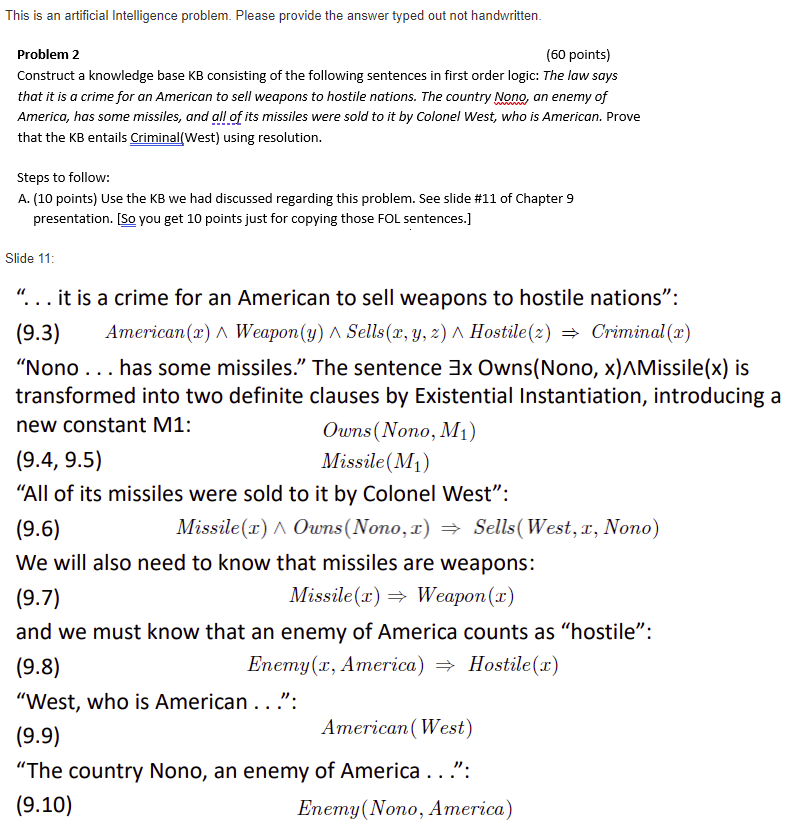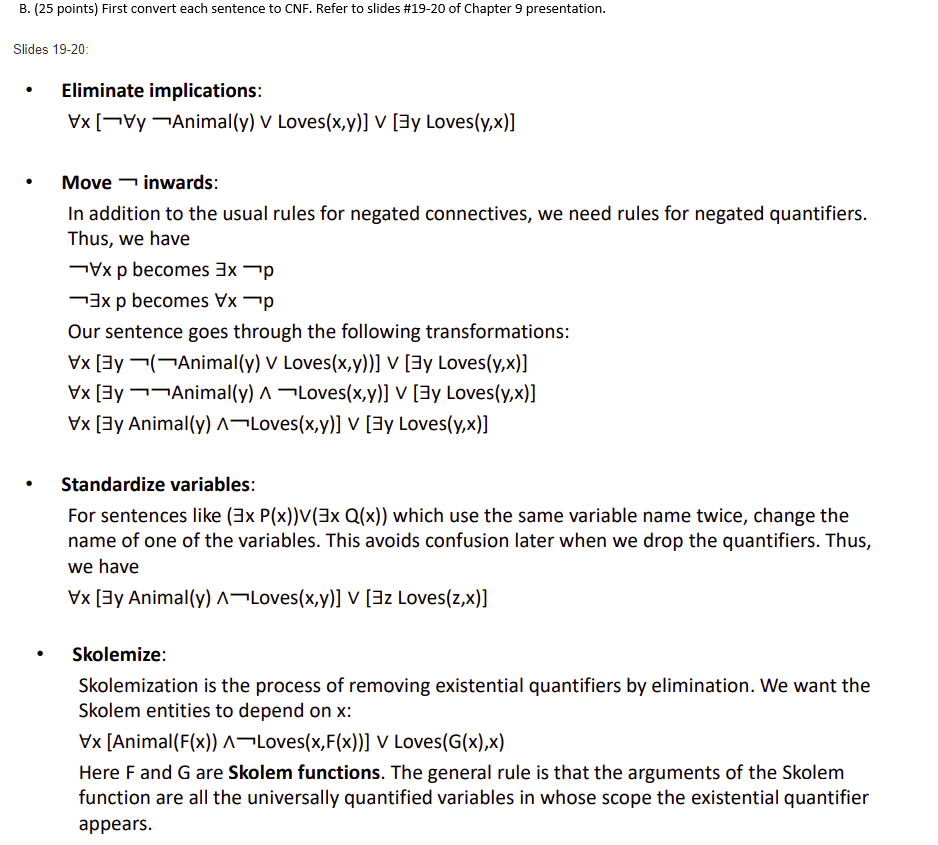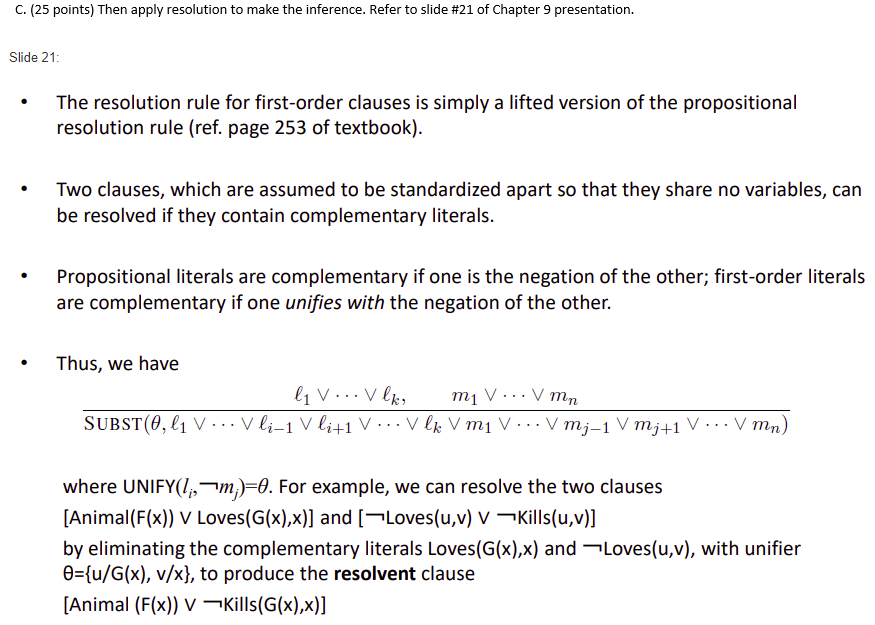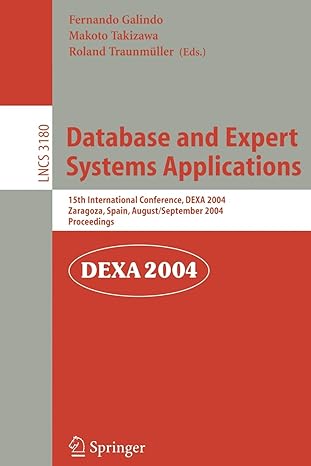



This is an artificial Intelligence problem. Please provide the answer typed out not handwritten. Problem 2 (60 points) Construct a knowledge base KB consisting of the following sentences in first order logic: The law says that it is a crime for an American to sell weapons to hostile nations. The country Nono, an enemy of America, has some missiles, and all of its missiles were sold to it by Colonel West, who is American. Prove that the KB entails Criminal(West) using resolution. Steps to follow: A. (10 points) Use the KB we had discussed regarding this problem. See slide #11 of Chapter 9 presentation. [So you get 10 points just for copying those FOL sentences.] Slide 11: ... it is a crime for an American to sell weapons to hostile nations": (9.3) American (2) A Weapon(y) A Sells(x, y, z) A Hostile(2) = Criminal(2) Nono ... has some missiles. The sentence 3x Owns(Nono, x)AMissile(x) is transformed into two definite clauses by Existential Instantiation, introducing a new constant M1: Owns (Nono, M1) (9.4, 9.5) Missile(M1) All of its missiles were sold to it by Colonel West": (9.6) Missile(1) A Owns (Nono, I) = Sells( West, T, Nono) We will also need to know that missiles are weapons: (9.7) Missile(r) Weapon (2) and we must know that an enemy of America counts as "hostile": (9.8) Enemy(1, America) * Hostile(1) "West, who is American ...": (9.9) American (West) The country Nono, an enemy of America ...": (9.10) Enemy(Nono, America) B. (25 points) First convert each sentence to CNF. Refer to slides #19-20 of Chapter 9 presentation. Slides 19-20 Eliminate implications: VxVy Animal(y) v Loves(x,y)] v [3y Loves(y,x)] Move inwards: In addition to the usual rules for negated connectives, we need rules for negated quantifiers. Thus, we have Vx p becomes 3x 7p 3x p becomes Vxp Our sentence goes through the following transformations: Vx [By Animal(y) v Loves(x,y))] v [3y Loves(y,x)] Vx [By Animal(y) A Loves(x,y)] v [Ey Loves(y,x)] Vx [3y Animal(y) A-Loves(x,y)] v [zy Loves(y,x)] Standardize variables: For sentences like (3x P(x)) (3x Q(x)) which use the same variable name twice, change the name of one of the variables. This avoids confusion later when we drop the quantifiers. Thus, we have Vx [3y Animal(y) A Loves(x,y)] v [3z Loves(z,x)] Skolemize: Skolemization is the process of removing existential quantifiers by elimination. We want the Skolem entities to depend on x: Vx [Animal(F(x)) A Loves(x,F(x))] v Loves(G(x),x) Here F and Gare Skolem functions. The general rule is that the arguments of the Skolem function are all the universally quantified variables in whose scope the existential quantifier appears. Drop universal quantifiers: At this point, all remaining variables must be universally quantified. Moreover, the sentence is equivalent to one in which all the universal quantifiers have been moved to the left. We can therefore drop the universal quantifiers: [Animal(F(x)) ^ Loves(x,F(x))] v Loves(G(x),x) Distribute V over A: [Animal(F(x)) v Loves(G(x),x)] ^ Loves(x,F(x)) v Loves(G(x),x)] This step may also require flattening out nested conjunctions and disjunctions. C. (25 points) Then apply resolution to make the inference. Refer to slide #21 of Chapter 9 presentation. Slide 21: The resolution rule for first-order clauses is simply a lifted version of the propositional resolution rule (ref. page 253 of textbook). Two clauses, which are assumed to be standardized apart so that they share no variables, can be resolved if they contain complementary literals. Propositional literals are complementary if one is the negation of the other; first-order literals are complementary if one unifies with the negation of the other. Thus, we have la v...vlk, m1 V... V mn SUBST(0,11 V... V li-1 V li+1 V... V lk V m V... V mj-1 V mj+1 V ... V mn) where UNIFY(1;, m;)=0. For example, we can resolve the two clauses [Animal(F(x)) V Loves(G(x),x)] and [Loves(u,v) v Kills(u,v)] by eliminating the complementary literals Loves(G(x),x) and Loves(u, v), with unifier ={u/G(x), v/x}, to produce the resolvent clause [Animal (F(x)) v Kills(G(x),x)] This is an artificial Intelligence problem. Please provide the answer typed out not handwritten. Problem 2 (60 points) Construct a knowledge base KB consisting of the following sentences in first order logic: The law says that it is a crime for an American to sell weapons to hostile nations. The country Nono, an enemy of America, has some missiles, and all of its missiles were sold to it by Colonel West, who is American. Prove that the KB entails Criminal(West) using resolution. Steps to follow: A. (10 points) Use the KB we had discussed regarding this problem. See slide #11 of Chapter 9 presentation. [So you get 10 points just for copying those FOL sentences.] Slide 11: ... it is a crime for an American to sell weapons to hostile nations": (9.3) American (2) A Weapon(y) A Sells(x, y, z) A Hostile(2) = Criminal(2) Nono ... has some missiles. The sentence 3x Owns(Nono, x)AMissile(x) is transformed into two definite clauses by Existential Instantiation, introducing a new constant M1: Owns (Nono, M1) (9.4, 9.5) Missile(M1) All of its missiles were sold to it by Colonel West": (9.6) Missile(1) A Owns (Nono, I) = Sells( West, T, Nono) We will also need to know that missiles are weapons: (9.7) Missile(r) Weapon (2) and we must know that an enemy of America counts as "hostile": (9.8) Enemy(1, America) * Hostile(1) "West, who is American ...": (9.9) American (West) The country Nono, an enemy of America ...": (9.10) Enemy(Nono, America) B. (25 points) First convert each sentence to CNF. Refer to slides #19-20 of Chapter 9 presentation. Slides 19-20 Eliminate implications: VxVy Animal(y) v Loves(x,y)] v [3y Loves(y,x)] Move inwards: In addition to the usual rules for negated connectives, we need rules for negated quantifiers. Thus, we have Vx p becomes 3x 7p 3x p becomes Vxp Our sentence goes through the following transformations: Vx [By Animal(y) v Loves(x,y))] v [3y Loves(y,x)] Vx [By Animal(y) A Loves(x,y)] v [Ey Loves(y,x)] Vx [3y Animal(y) A-Loves(x,y)] v [zy Loves(y,x)] Standardize variables: For sentences like (3x P(x)) (3x Q(x)) which use the same variable name twice, change the name of one of the variables. This avoids confusion later when we drop the quantifiers. Thus, we have Vx [3y Animal(y) A Loves(x,y)] v [3z Loves(z,x)] Skolemize: Skolemization is the process of removing existential quantifiers by elimination. We want the Skolem entities to depend on x: Vx [Animal(F(x)) A Loves(x,F(x))] v Loves(G(x),x) Here F and Gare Skolem functions. The general rule is that the arguments of the Skolem function are all the universally quantified variables in whose scope the existential quantifier appears. Drop universal quantifiers: At this point, all remaining variables must be universally quantified. Moreover, the sentence is equivalent to one in which all the universal quantifiers have been moved to the left. We can therefore drop the universal quantifiers: [Animal(F(x)) ^ Loves(x,F(x))] v Loves(G(x),x) Distribute V over A: [Animal(F(x)) v Loves(G(x),x)] ^ Loves(x,F(x)) v Loves(G(x),x)] This step may also require flattening out nested conjunctions and disjunctions. C. (25 points) Then apply resolution to make the inference. Refer to slide #21 of Chapter 9 presentation. Slide 21: The resolution rule for first-order clauses is simply a lifted version of the propositional resolution rule (ref. page 253 of textbook). Two clauses, which are assumed to be standardized apart so that they share no variables, can be resolved if they contain complementary literals. Propositional literals are complementary if one is the negation of the other; first-order literals are complementary if one unifies with the negation of the other. Thus, we have la v...vlk, m1 V... V mn SUBST(0,11 V... V li-1 V li+1 V... V lk V m V... V mj-1 V mj+1 V ... V mn) where UNIFY(1;, m;)=0. For example, we can resolve the two clauses [Animal(F(x)) V Loves(G(x),x)] and [Loves(u,v) v Kills(u,v)] by eliminating the complementary literals Loves(G(x),x) and Loves(u, v), with unifier ={u/G(x), v/x}, to produce the resolvent clause [Animal (F(x)) v Kills(G(x),x)]










